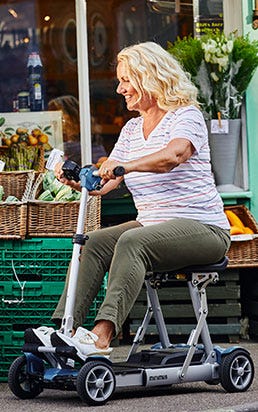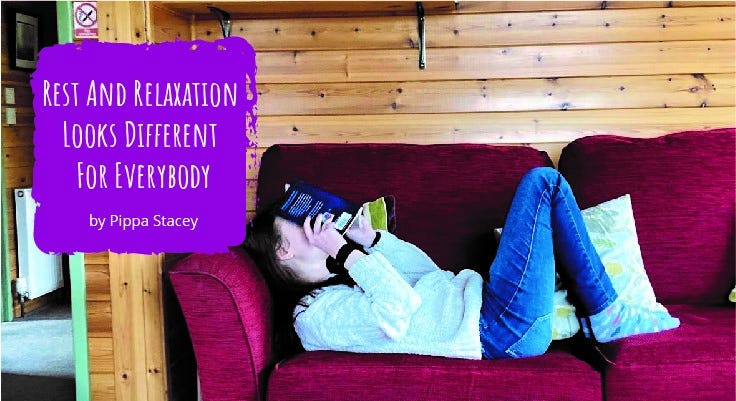It’s no secret that rest and relaxation seem to be treated like something of a commodity these days. They’re words we use frequently in day-to-day life and concepts we seemingly understand the importance of, and yet achieving true rest and relaxation in the world we live in seems to be becoming more and more difficult… even more so for disabled people. As somebody with a chronic illness, I find people’s interpretations of self-care absolutely fascinating. I’ll often look at people’s evening routines or what they’re doing to unwind: face masks, baking, playing calming music, talking with friends… and I can’t help but draw comparisons. Because quite frankly, that one relaxing evening sounds like it could drain my entire weeks’ worth of energy. If I were to follow that same pattern, these activities that help people ‘recharge’ would most likely drain the little of what was left in my own battery. Put simply, I’d need to rest after the resting. For a long time, I wondered whether such approaches to rest and relaxation were performative. After all, the marketing and advertising industry tries to convince us that in order to get truly restful rest we *need* to buy the latest products and jump on board the newest trends. It makes sense that consumerism would find a way to infiltrate how we think about switching off and recharging. The knock-on effect, though, is that many of us fall into the trap of thinking that if we’re not doing these things the same as how everybody else seems to be doing them, then somehow we’re doing it wrong. And again, I think this is something that rings particularly true for disabled people. This year, I’ve been having an ongoing struggle with seeking restful rest. I find it difficult to switch off even at the best of times, and I’ve tried my hand at many of these popularised methods of winding down… with varying levels of success. To hand-pick a few examples:
- I tried a face mask designed for sensitive skin, and yet my sensitive skin took full offence at this and broke out into itchy patches.
- I brought lavender spray into my bedroom in the evening before realising that thanks to running my social enterprise for five years (creating bespoke products for people with chronic illness including gently scented items), it turns out I automatically associate the smell of lavender with the smell of work.
- I listened to gentle music knowing full-well it would have the opposite effect on me – having grown up as a dancer, any time I hear music, I automatically dance and choreograph in my head. In fact, there are some pieces of classical music that automatically take me back to past memories and cause an unhelpful surge of adrenaline in my body. Not ideal when you’re supposed to be chilling out, really.
The more I thought about it, the more it dawned on me. My struggles with these mainstream forms of rest and relaxation aren’t simply me being a special snowflake – the fact of the matter is that our lives and health needs are so unique to us that of course there’s going to be variability in what we need to do to relax and unwind. I haven’t had enough brain power to fully explore this area yet, but I recently read a fascinating piece about the seven types of what Dr Saundra Dalton-Smith terms Sacred Rest. This approach argues that to fully alleviate the fatigue and weariness we as humans tend to navigate (even non-disabled people living without the joys of energy-limiting chronic illness), we need to account for physical, mental, emotional, social, creative, sensory, and spiritual rest. Ironically I feel slightly exhausted just thinking about accommodating all those different needs, but I can’t deny that this approach deeply resonates with me – especially as somebody who diligently practices physical rest and yet constantly forgets to give themselves the cognitive respite their old noggin is crying out for. It’s clear that there’s much to explore here and I hope I’ll be able to evolve my own rest as I continue to learn, but for now, I thought I’d share some potentially more accessible methods of relaxation that have been more effective for me:
- A warm bath with Epsom Salts and a soft bath pillow to rest my head on. I haven’t quite figured out how to calm my mind down when I’m in the bath, but it does wonders for relaxing a fatigued and painful body.
- Paint-by-numbers kits. As much as I wish I enjoyed arts and crafts, they’ve never been for me – but paint by numbers seems to bring me some comfort and gentle focus when my brain feels like it’s going at a thousand miles per hour. I usually sit on the floor and rest on my coffee table which can get uncomfortable, so it may be time for a comfy lap tray to level up my game…
- It may sound counter-intuitive, but sometimes the only way I can tear myself away from screens (typical millennial) is by getting out and about – something that wouldn’t be possible without my power-chair. I hope, when my body and circumstances allow it, I can get better at taking myself out for a ‘walk’ just for the sake of it – just for some time outdoors, even if there isn’t somewhere I need to be.
Perhaps some of those approaches or the ideas behind them will resonate with you. Perhaps they won’t – and that’s okay. Rest and relaxation are subjective, and different things will work for everybody. It’s easy to forget that, and yet so important that we remember. If you take one thing away from this article, I hope you’ll join me in exploring some new and potentially slightly less unconventional methods of unwinding, especially as we make our way into a New Year. Your needs are valid, and you know better than anybody what will be most helpful for you. In the meantime, what do you do for rest and relaxation? Any suggestions? The quirkier the better, in my opinion – I’d love to hear all about it!


 Price Match Promise
Price Match Promise
 Next day delivery, 7 days a week
Next day delivery, 7 days a week
 Nationwide Showrooms
Nationwide Showrooms
 Rated Excellent
Rated Excellent







